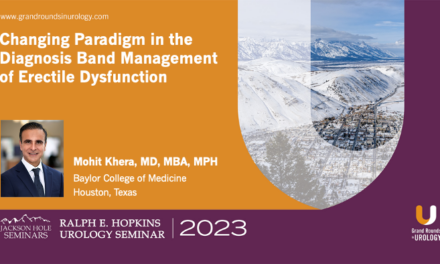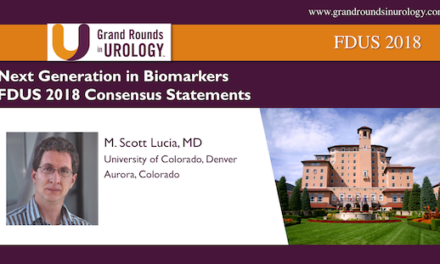Manoj J. Monga, MD, FACS, presented “Mini PCNL versus Standard PCNL” during the 29th Annual Perspectives in Urology: Point-Counterpoint, on November 18, 2021, in Coronado Island, San Diego, California.
How to cite: Monga, Manoj J. “Mini PCNL versus Standard PCNL.” November 18, 2021. Accessed May 2025. https://grandroundsinurology.com/mini-pcnl-versus-standard-pcnl/
Mini PCNL versus Standard PCNL – Summary
Manoj J. Monga, MD, FACS, Professor and Chair of Urology at the University of California, San Diego, compares mini percutaneous nephrolithotomy (mini PCNL) for renal stone removal to standard percutaneous nephrolithotomy (PCNL). He begins by looking at who needs a PCNL, explaining that he typically performs them on patients with a stone larger than 15mm, but that he also sometimes performs PCNL on stones when there are anatomical considerations that would make it difficult to get to the stone ureteroscopically. Dr. Monga notes that PCNL has the best outcomes and results in the best quality of life of any stone removal technique. He then poses the question: Why not treat every stone with PCNL? The answer, of course, he says, is because 4/1000 patients die from PCNL due to sepsis. Dr. Monga then moves on to discuss mini PCNL, noting that it was originally assumed to potentially be safer than PCNL, but that a 2001 study showed there was no advantage. He also observes that the smaller sheath used in mini PCNL actually increases the risk of infectious complications, and that outcomes are worse and operating room time is longer with mini PCNL compared to standard. However, Dr. Monga notes, there does appear to be a lower risk for bleeding and fewer transfusions, which might result in less kidney volume loss.
About the 29th Annual Perspectives in Urology: Point Counterpoint conference:
Presented by Program Chair and Grand Rounds in Urology Editor-in-Chief E. David Crawford, MD, this conference brought together leading experts in urology, medical oncology, and radiation oncology to discuss and debate the latest topics in genitourinary cancers, primarily prostate cancer and bladder cancer. This interactive conference offered topical lectures, pro/con debates, interesting-case presentations, interactive panel discussions, and interactive audience and faculty networking.
ABOUT THE AUTHOR
Manoj J. Monga, MD, FACS, is Professor and Chair of Urology at the University of California, San Diego. He previously served as Director of the Stevan B. Streem Center for Endourology & Stone Disease at the Glickman Urological and Kidney Institute at the Cleveland Clinic and the Joseph Sorkness Family Endowed Professor and Vice-Chair of Urologic Surgery and Director of Endourology & Stone Disease at the University of Minnesota. Dr. Monga received his medical degree from the Chicago Medical School and completed his residency at Tulane University School of Medicine.
Dr. Monga is recognized as an international authority in endourology and stone disease, and has been an invited speaker in India, Thailand, Brazil, Italy, Greece, Mexico, China, United Kingdom and the Netherlands. He has also acted as a Visiting Professor at many of the major medical centers in the United States.
Dr. Monga has served on numerous AUA committees, including the Quality Improvement & Patient Safety Committee, Abstract Committee, and Urology Care Foundation’s Outreach Committee. He also served as Chair of the North Central Section’s Education Committee. Dr. Monga has served as the section editor of the Journal of Endourology and served on several other editorial boards, including the Indian Journal of Urology and the International Brazilian Journal of Urology.




